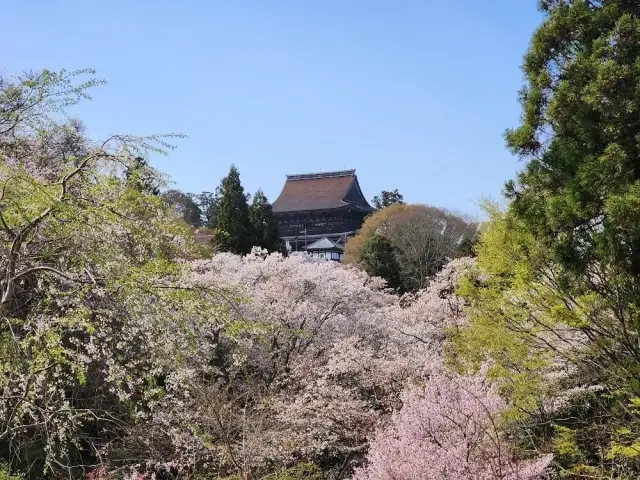https://www.dekitabi.com/itinerary/nara-day-trip-mount-yoshino
Nestled in the heart of Nara Prefecture, the Yoshino region is a treasure trove of history, culture, and natural beauty. Renowned for its stunning cherry blossoms, Yoshino is also home to several sacred sites and historic temples that offer a glimpse into Japan’s rich spiritual heritage. This article delves into the enchanting attractions of Yoshino Shrine, Kinpusenji Temple, Yoshimizu Shrine, Sakuramotobo, and Yoshino Mikumari Shrine.
Yoshino Shrine: A Sacred Sanctuary

https://www.dekitabi.com/attraction/yoshino-jingu
Yoshino Shrine, dedicated to Emperor Godaigo, is a serene sanctuary that stands as a testament to the emperor’s lasting legacy. Established in 1889, the shrine honors the memory of Emperor Godaigo, who played a pivotal role in the Kenmu Restoration. The shrine’s tranquil surroundings and stunning architecture make it a must-visit destination for those seeking to connect with Japan’s imperial history.
Visitors to Yoshino Shrine can explore the main hall, which houses a revered statue of Emperor Godaigo. The shrine’s grounds are also home to ancient cedar trees, creating a peaceful atmosphere perfect for reflection and meditation. Throughout the year, the shrine hosts various festivals and events, offering a unique opportunity to experience traditional Japanese culture.
Kinpusenji Temple: A Spiritual Epicenter

https://www.dekitabi.com/attraction/kimpusen-ji
Kinpusenji Temple is one of Japan’s most important religious sites, serving as the head temple of the Shugendo sect of Buddhism. Located on Mount Yoshino, this temple is dedicated to Zao Gongen, a deity believed to protect the mountain and its surroundings. The temple’s imposing main hall, known as the Zaodo, is the second largest wooden structure in Japan and a marvel of traditional Japanese architecture.
Kinpusenji Temple is a UNESCO World Heritage site, recognized for its historical and cultural significance. Pilgrims and tourists alike are drawn to the temple to witness its majestic beauty and participate in its spiritual practices. The temple grounds offer breathtaking views of the surrounding mountains, making it a perfect spot for nature lovers and spiritual seekers.
Yoshimizu Shrine: A Historic Retreat

https://www.dekitabi.com/attraction/yoshimizu-shrine
Yoshimizu Shrine, perched on the slopes of Mount Yoshino, boasts a rich history intertwined with Japan’s imperial and samurai heritage. Originally a retreat for Emperor Godaigo, the shrine later became a base for the famous samurai warrior Minamoto no Yoshitsune. Today, the shrine is a peaceful haven that offers stunning views of the Yoshino mountains and valleys.
The shrine’s main hall, built in the traditional style, houses various artifacts and relics related to Emperor Godaigo and Minamoto no Yoshitsune. Visitors can also explore the surrounding gardens, which are especially beautiful during the cherry blossom season. Yoshimizu Shrine is an ideal destination for history enthusiasts and those looking to immerse themselves in Japan’s storied past.
Sakuramotobo: A Historic Temple with Stunning Views

https://www.dekitabi.com/attraction/sakuramoto-bo-temple
Sakuramotobo, another significant site on Mount Yoshino, is a historic temple complex known for its stunning views and spiritual ambiance. Founded in the 7th century, the temple is associated with the ascetic practices of the Shugendo sect. The temple’s name, which means “Cherry Blossom Base Temple,” reflects its location amidst the famed cherry blossoms of Yoshino.
The main hall of Sakuramotobo houses a statue of En no Gyoja, the founder of Shugendo, and is a place of worship and reflection. The temple grounds also feature several smaller halls and pagodas, each with its unique charm and historical significance. Visitors can enjoy panoramic views of the cherry blossoms in spring, making Sakuramotobo a picturesque and serene destination.
Yoshino Mikumari Shrine: Guardian of Water and Fertility

https://www.dekitabi.com/attraction/yoshino-mikumari-jinja
Yoshino Mikumari Shrine, dedicated to the deity Mikumari, is a sacred site known for its role in water and fertility rituals. This ancient shrine, located on the slopes of Mount Yoshino, has been a place of worship for centuries. The shrine’s peaceful setting and beautiful architecture make it a tranquil retreat for visitors seeking spiritual solace.
The main hall of Yoshino Mikumari Shrine, constructed in the traditional style, houses the revered deity and is the focal point of various ceremonies and rituals. The shrine is particularly famous for its connection to water, with several springs and streams in the vicinity believed to have sacred properties. Pilgrims and visitors come to the shrine to pray for fertility, safe childbirth, and abundant harvests.
Conclusion
The Yoshino region, with its sacred sites and historic temples, offers a unique blend of spiritual heritage and natural beauty. From the imperial history of Yoshino Shrine to the spiritual epicenter of Kinpusenji Temple, the historic retreat of Yoshimizu Shrine, the picturesque Sakuramotobo, and the serene Yoshino Mikumari Shrine, each site provides a distinct and enriching experience. Exploring these revered sites allows visitors to connect with Japan’s rich cultural tapestry and appreciate the timeless traditions that continue to shape the nation’s identity.
Whether you are a history buff, a spiritual seeker, or a nature lover, the Yoshino region promises a journey of discovery and reflection. Embrace the tranquility, immerse yourself in the culture, and let the sacred sites of Yoshino leave an indelible mark on your heart and soul.


Leave a Reply